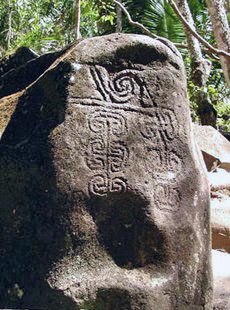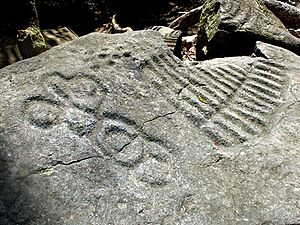Altavista petroglyph complex facts for kids
The Altavista petroglyph complex is a special place with ancient rock carvings. It is located near the village of Chacala in Nayarit, Mexico. People also call this area "La Pila del Rey" or "The Petroglyphs." It is close to the Pacific Ocean.
This area was once home to the Tecoxquin (Tequectequi) people. They lived here a very long time ago, around 2000 to 2300 BCE. There are 56 petroglyphs (rock carvings) here. We don't know exactly how old they are. Besides being important for history and archaeology, the site is still a sacred place for the Huicholes. They visit to leave offerings and perform ceremonies.
Before the Spanish arrived, the Mazatán people lived in this area. They were part of the Xalisco-Zacualpan Kingdom.
Ancient Rock Carvings: The Petroglyphs
The Tecoxquines, an ancient group, carved pictures into volcanic stones over two thousand years ago. These carvings are near a place called Las Piletas. The petroglyphs might have shown things important to their daily lives. This includes health, having children, rain, and good crops. The carvings could have been prayers or gifts to the gods who helped with these things.
There are more than 2000 carvings found across an area of about 80 hectares.
Who Were the Tecoxquines?
The Tecoxquines were the first people to live in the Altavista area. This native group lived along the southern coast of Nayarit and parts of Jalisco, Mexico. They were mostly farmers, fishermen, and salt makers. They also traded things like cocoa and cotton.
The Tecoxquines lived in many villages. These villages were controlled by a place called Teuzacualpan Chila Valley (which is now the city of Zacualpan). They traded a lot, reaching as far north as Sinaloa and as far south and east as Colima and Michoacán.
Tecoxquin Beliefs and Ceremonies
The Tecoxquines had many religious ceremonies at this site. They believed in communicating with their gods and spirits. They would use special plants to help them reach a state where they could talk to their gods.
The Tecoxquines Today
After the Spanish arrived, many Tecoxquines disappeared because of sickness and hard work. Today, people in the region still tell stories about "white Indians." These are said to be ghosts who appear from the mountains to honor their old gods.
The Tecuales, who are ancestors of the modern Huichol people, lived in the ancient Tecoxquin villages.
The Importance of Water
Nayarit State gets a lot of rain, especially from May to October. The Altavista mountains bring heavy rains. This leaves drier areas to the east. Because there was so much water, Altavista was seen as a very special place.
The Cosmic Tree: Tamoanchan
Tamoanchan is a mythical place like a paradise. It was important to ancient cultures in central Mexico. Tamoanchan was seen as a "cosmic tree" that connected everything in the world. Its roots were underground, where water and new life came from. Its trunk was on the ground, where people lived. The top of the tree reached into the sky, where the gods and rain lived. The Ceiba tree often represented Tamoanchan.
Tlalocan: The Water Paradise
Ancient Mesoamerican people believed water was underground. So, the underworld was seen as a place of new life. Tlalocan was like an "underground water paradise." It was home to "Chanes," who were water spirits. It also held the spirits of people who had drowned or died because of water. Tlalocan was also where the legendary crocodile Cipactli lived. This "earth monster" symbolized new life and growth.
The Cross and Its Meaning
For the Tecoxquines and most ancient Mesoamerican people, the cross was a map of the universe. It stood for five sacred directions: the four main directions (north, south, east, west) and the center. Each direction was linked to certain gods, colors, and sacred places. It was also linked to the four trees that formed the Tamoanchan kingdoms. The idea of a universe with four corners is still important to native people in Mexico today. They show this with crosses, diamond shapes, and similar forms.
The first historical writings about Altavista from 1612 mention many crosses. They also talk about a special "devout Christ" that local people honored. This might have been a reference to the "corn man," a figure that symbolized growth and new life. Local farmers still leave offerings like candles and salt for this figure. They do this to help their coffee and tobacco crops grow well.
In the early 1600s, the Spanish believed that the Apostle Matthew had traveled to the New World before they arrived. They thought he had taught the native people about Christianity. This idea might explain why crosses were carved into the Altavista rocks.
Talking with the Gods
The Altavista rocks were probably seen as connected to the mythical Tamoanchan trees. These trees linked the underworld, the earth, and the sky. People believed their prayers would go up through the trees to the gods. In return, gifts from the gods, like rain, new life, and good health, would come back down to earth the same way. For the Tecoxquines, the Altavista rocks were a way to talk with their gods.
Symbols and Their Meanings
Spirals, wavy lines, and other symbols carved into the Altavista rocks were probably a special prayer language for the gods. Since the Tecoxquines were farmers, they cared a lot about rain, healthy land, and the regular changes of seasons. We may never know the exact meaning of all the symbols. However, spirals have been thought to represent the Sun, storms, wind, or the natural cycle of wet and dry seasons.
The Huichol People Today
Huichol native people sometimes visit Altavista. They originally lived in the Nayar mountains, but some have recently moved to the Las Varas area. They bring offerings and perform ceremonies for Nakahue, their "fertility grandmother," and Tatevari, their "grandfather of fire." Some Huicholes also travel to the nearby Chacala Port. There, they find ancient petroglyphs and leave offerings for Tatei Aramara, their "mother Ocean."
See also
 In Spanish: Altavista (Nayarit) para niños
In Spanish: Altavista (Nayarit) para niños



